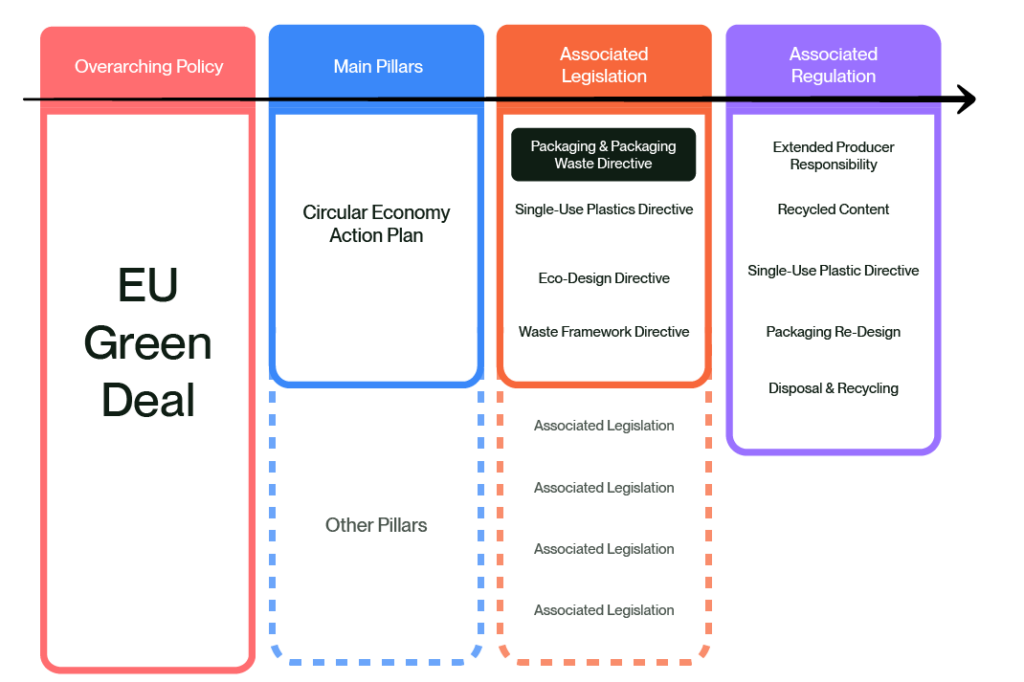Home – Regulations – EU Packaging and Packaging Waste Regulation (PPWR)
Download the PPWR Guide
Access our summary document, with all the essential information you need.
Table of contents
Share this guide
What is the PPWR?
On 30th November 2022, the European Commission published an update to the Packaging and Packaging Waste Directive (PPWD) as part of the Circular Economy package. The 118-page document contains numerous details that organisations will need to decipher to understand the implications this draft regulation may have on their packaging and business.
A year on and the Packaging and Packaging Waste Regulation (PPWR) has now been adopted by the EU Parliament with a few amendments and will begin the process of being adopted by member states. There have been tweaks to reuse targets and exact wording across the legislation, but the overall direction remains the same.
The overarching aim of the regulation is to reduce packaging production and associated waste as a primary objective, improve the recyclability of any packaging and grow the market for recycled content. The nature of this proposed regulation is widespread which will mean that it will impact anyone who places packaging on the EU market both small and large.

What are the proposed changes to the regulation?
One of the most important and impactful proposed changes to the PPWD is that it has now been upgraded to a regulation to increase consistency across the EU, meaning it will be mandatory across Member States. Here is a summary of key differences between the directive and the new regulation:
| Packaging and Packaging Waste Directive | Packaging and Packaging Waste Regulation |
|---|---|
| The main objective of the Directive was to harmonise national measures on packaging and the management of packaging waste and to provide a high level of environmental protection. | The intended overarching objective of the Regulation is to reduce packaging waste in the first instance, improve recyclability and grow the market for recycled content. |
| The Directive was elective and therefore has been enacted by Member States in different ways and timescales. | Once the regulation is ratified in law, it is mandatory for Member States to act. |
| Limited focus on waste reduction targets. Emphasis instead on packaging waste recycling targets. | Waste reduction targets for EU Member states and measures to tackle ‘overpackaging’. |
| Single Use Plastic Directive (SUPD) bans. | *Additional packaging formats banned that complement and build on existing bans from SUPD. |
| No “recyclability” definition. | All packaging to be fully recyclable: Designed for Recycling by 2030 and ‘Recycled at Scale’ by 2035. “Recyclability” definition includes terminology such as ‘Recycled at scale’ intended to be part of the Design for Recycling (DfR) delegated act. |
| Extended Producer Responsibility (EPR) was sporadically implemented across Member States. | Harmonised eco-modulated EPR fees in every Member State based on packaging recyclability credentials and recycled content. |
| No recycled content targets. | Minimum recycled content targets for plastic packaging for 2030 and 2040. Exact targets to be written in a separate delegated act. |
| No reuse or refill focus. | Specific 2030 and 2040 targets for a proportion of packaging to be made available in reusable and/or refillable packaging. |
| No mandatory labelling. | Harmonised labelling scheme on material composition including recycled content and instructions to consumers on how to dispose, sort and/or reuse. |
| No mention of Deposit return schemes (DRS). | Mandatory DRS to be set up by 1 January 2029 for all single-use plastic and metal beverage containers up to 3 litres. Packaging containing wine, spirits, milk and milk products will be excluded. |
*Additional packaging format bans
- Single-use plastic grouped packaging (such as collation films, shrink wrap) that enables end-users to purchase more than one product.
- Single-use plastic/composite/other packaging (such as nets, bags, trays) for fresh fruit and vegetables except if required to prevent water loss, microbiological hazards or physical shocks, etc.
- Expanded Polystyrene (EPS) in retail food packaging, excluding fish boxes.
- Single-use plastic/composite/other packaging filled and consumed within the premises of the Hotels, Restaurants and Catering (HORECA) sector.
- Single-use plastic/composite/other packaging used for condiments, preserves, sauces, milk, sugar, and seasoning for eating-in or takeaway in the HORECA sector.
- Single-use hotel miniature packaging (shampoo, cosmetics, etc.).
In addition, the amended regulation now includes a ban on the use of Bisphenol A and PFASs (per- and polyfluorinated alkyl substances, also known as ‘forever chemicals’) in food contact packaging to be implemented 18 months from EIF (therefore expected summer 2026).
Download the PPWR guide
What are the key dates?
The proposed regulation is under review by the European Council and the European Parliament with the overall legislative process expected to take 18 months after the initial publication and the regulation is expected to be enacted by the end of 2024.
A key step in this process has been passed with the EU Parliament adopting the amended legislative text on the 22nd November 2023. The process of adoption by member states will now begin.
What are the impacts of the proposed regulation?
Anthesis supports the overall ambition of the proposed regulation which is to reduce the impact of packaging and packaging waste on the environment and ensure that resources are kept within a circular economy.
From an industry perspective, there has been a mixed response to the first official draft of the PPWR. This has been largely dependent on the various sectors it will impact; for example, the food industry has expressed concerns about the support that will be provided to implement the revisions in food-packaging applications particularly around recycled content, whereas others such as trade associations are pointing out gaps in the PPWR, for instance, downcycling.
Documents that were leaked before publication provided insights into some of the detail on several expected targets and definitions. However, the removal of these insights in the official documentation has caused some confusion as to whether there will be subsequent changes due to initial reactions across industries. The official proposal informs us that recycled content and other targets will be delegated into separate acts which provides regulators with the tools they need to add new provisions and particular detail post-publication. This could provide a safety net for some industries but more widely this could pose a serious risk to most sectors.
How should organisations prepare?
Taking a proactive vs reactive approach will benefit businesses in the long-term. Engaging with industry peers, trade associations and other third parties to collate knowledge and reduce the burden of individual responses to the same challenges will be vital during this time to ensure your business is adequately prepared.
The revised regulation will have a multitude of different implications for different obligated parties up and down the supply chain. Through strategic impact assessments, businesses should understand their packaging portfolios and develop robust packaging strategies that will contribute to the overall objective of the draft regulation. The extent of your exposure will vary from industry to industry, contact the Anthesis team to understand how the proposed regulation impacts you and how to manage your response.
Get in touch
We are the world’s leading purpose driven, digitally enabled, science-based activator. And always welcome inquiries and partnerships to drive positive change together.
Related Content
Get in touch
We’d love to hear from you
We are the world’s leading purpose driven, digitally enabled, science-based activator. And always welcome inquiries and partnerships to drive positive change together.










